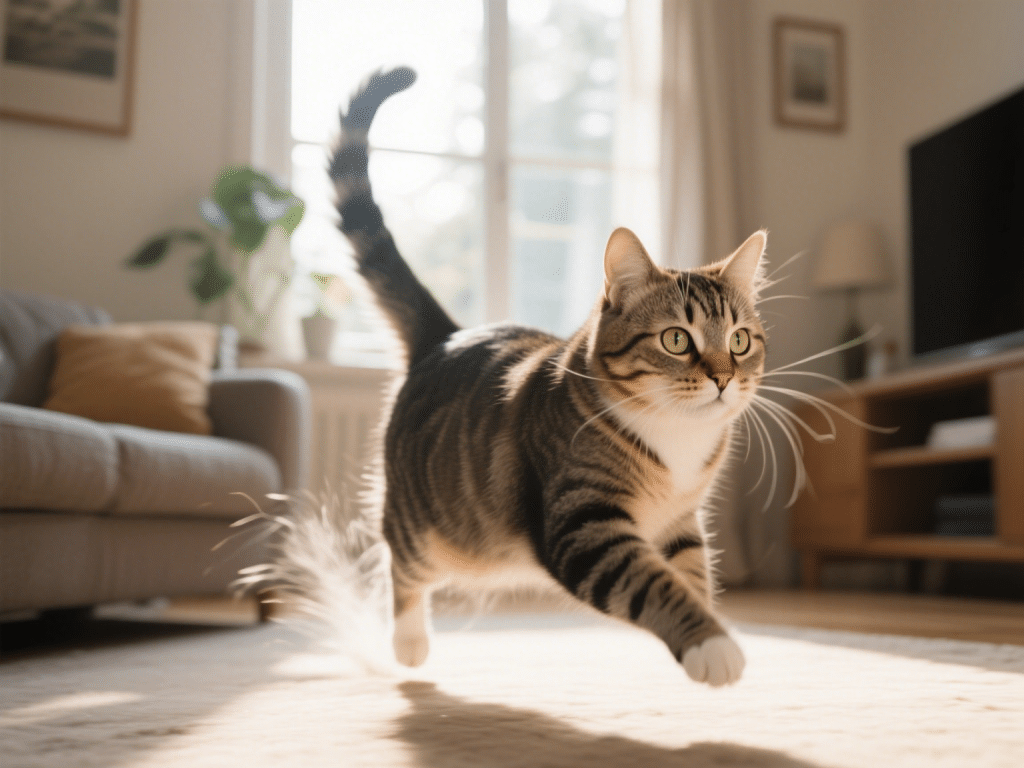
As a feline behavior specialist with over a decade of hands‑on experience caring for and studying domestic cats, I’ve seen countless kitty sprints that leave owners both amused and perplexed. Those sudden bursts of energy—affectionately known as “zoomies”—are an integral part of your cat’s natural repertoire. In this guide, we’ll explore the roots of zoomies, how they benefit your cat’s physical and mental health, and strategies you can use to keep those midnight sprints from turning your home into an obstacle course.
What Exactly Are Zoomies?
Zoomies (technically “Frenetic Random Activity Periods,” or FRAPs) are short episodes of high‑speed running, pouncing, and playful antics. You’ve likely witnessed your cat tear across the room at 2 a.m. or race in tight circles around furniture. Far from random, these episodes are deeply rooted in instinct: they mimic the bursts of energy kittens use to practice hunting and escaping predators in the wild.
Why Cats Get the Zoomies
Energy Release
Cats sleep up to 18 hours a day. When they wake, pent‑up energy needs a safe outlet—zoomies provide exactly that.Hunting Instincts
Even indoor kitties retain predatory drives. Sudden sprints simulate chases and mock attacks on “prey,” keeping instincts sharp.Stress Relief
Environmental stressors—new furniture, guests, loud noises—can trigger excess energy. Zoomies discharge anxiety.Pure Joy
Sometimes, your cat is just having fun. Playful zoomies are a sign of a content, confident pet.
How to Encourage Healthy Zoomie Sessions
Scheduled Playtimes
Dedicate 10–15 minutes twice daily to interactive play with wand teasers or laser pointers. This structured exercise helps release energy before it builds up.Vertical Spaces
Install cat trees or shelves. Climbing provides exercise and mental stimulation, reducing the need for extreme bursts on the floor.Puzzle Feeders
Engaging your cat’s mind through treat puzzles slows feeding and mimics hunting, channeling energy productively.
Managing Zoomies Without Stress
While zoomies are normal, they can become problematic if they lead to knocked‑over vases or startled housemates. Here’s how to keep things under control:
Safe Zones: Create obstacle‑free play areas. Remove breakables and cover cords.
Redirect Before Takeoff: When you sense a zoom‑up—your cat crouches or eyes flick to a target—prompt a chase game with a toy.
Nighttime Rituals: Offer a final play session before bed followed by a small meal. A tired, satiated cat is less likely to sprint through your dreams.
When to Seek Veterinary Advice
Occasional zoomies are healthy. However, if your cat exhibits:
Extreme aggression during FRAPs
Loss of coordination or disorientation
Repetitive pacing without breaks
consult your veterinarian. These may signal underlying medical or neurological issues.
Insights from the Front Lines
“In my 12 years running a feline rescue, I’ve observed that cats with consistent enrichment rarely develop problematic zoomies,” says Dr. Elena Torres, DVM.
“Introducing new toys on a rotating schedule keeps stimulation fresh and reduces frantic bursts,” advises certified cat behaviorist Liam Nguyen.
Bringing It All Together
Zoomies showcase your cat’s playful spirit and natural instincts. By understanding triggers and providing targeted enrichment—interactive play, vertical territory, and puzzle feeders—you’ll transform chaotic sprints into healthy exercise. Embrace those zoomies as windows into your cat’s emotional world, and take pride in fostering a balanced, joyful companion.
I’m proud to share these insights from years of working alongside cats of all temperaments. May your living room remain intact—and your cat happily zooming.









Comments on " Mastering the Mystery of Your Cat’s Zoomies: A Comprehensive Guide" :